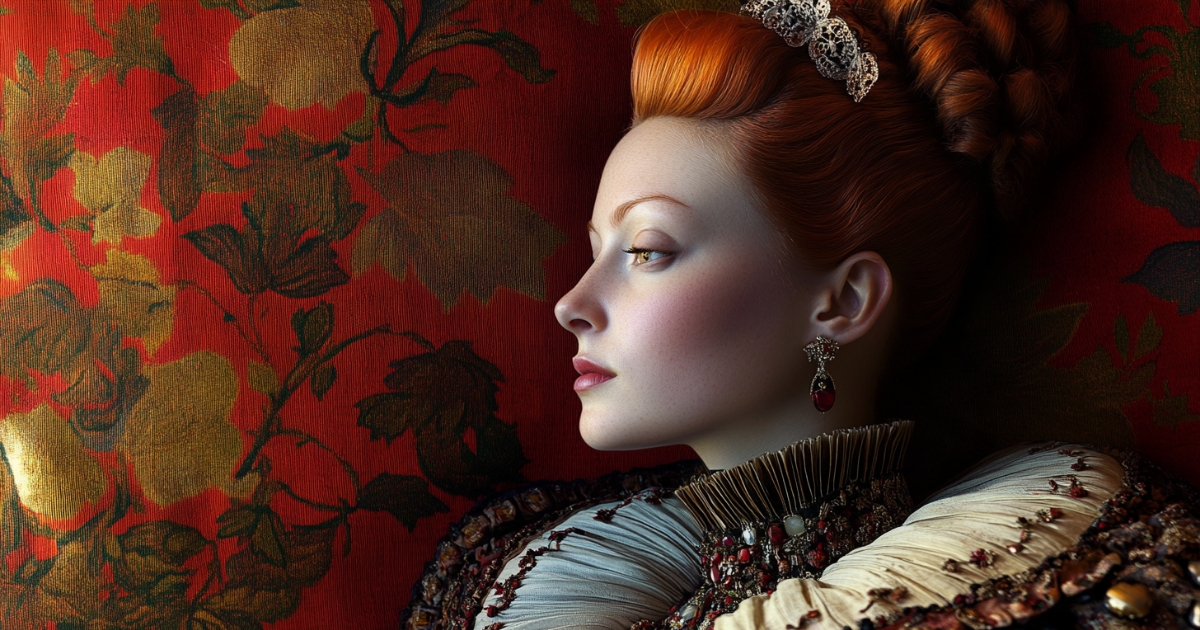In 16th century France, amidst religious wars and political conspiracies, one woman reigned at the center of power. Her name was Catherine de’ Medici. Born into the prominent Italian Medici family, she became Queen of France as the wife of Henry II and later served as regent, wielding significant influence over French politics.
But why did the shadow of “poison” linger around Catherine de’ Medici? Did she really use poisons to eliminate her political rivals? Or were these merely rumors?
This article focuses on the legend of Catherine de’ Medici’s “poison laboratory,” exploring the intersection of power and science in Renaissance France. Let’s delve into the truth behind the myth and uncover Catherine’s true character.
- Who Was Catherine de’ Medici?
- The French Wars of Religion and Catherine’s Politics
- Science and Magic in the Renaissance
- Catherine and the Poison Legend
- Catherine’s Scientific Contributions and Their Evaluation
- Reevaluation of Catherine de’ Medici
- What Catherine de’ Medici’s Life Teaches Us Today
- Conclusion
Who Was Catherine de’ Medici?
Catherine de’ Medici was born in 1519 in Florence, Italy. Orphaned at a young age, she was raised under the protection of her uncle, Pope Clement VII. At 14, she entered into a political marriage with the future King Henry II of France.
Initially, Catherine was an inconspicuous figure in the French court. However, after her husband’s accidental death, her political influence grew rapidly. Three of her sons (Francis II, Charles IX, and Henry III) successively ascended to the throne, but due to their youth or lack of governing ability, Catherine effectively held the reins of power.
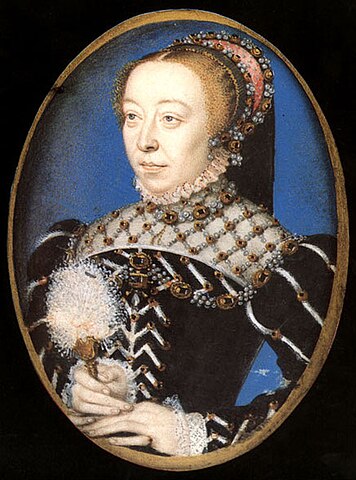
Portrait of Catherine de’ Medici by François Clouet (c. 1555). Her expression reflects a strong will and intelligence. By François Clouet
Given this background, what political challenges did Catherine face?
The French Wars of Religion and Catherine’s Politics
Catherine’s reign coincided with the French Wars of Religion. In 16th century France, conflicts between Catholics and Protestants (Huguenots) intensified. This was not merely a religious issue but had political and social dimensions as well.
Many French nobles converted to Protestantism and resisted the centralization of royal power. Meanwhile, the Catholic Church allied with the monarchy to maintain its influence. In this complex situation, Catherine attempted to reconcile both sides.
In 1562, Catherine issued the Edict of January, granting Protestants limited freedom of worship. Although this was a groundbreaking policy, it provoked Catholic opposition and ultimately failed to prevent the outbreak of religious wars.
Catherine continued to seek peace. The 1570 Edict of Saint-Germain granted Protestants freedom of worship and control over certain cities. She also arranged the marriage of her Catholic daughter Marguerite to the Protestant Henry of Navarre (later Henry IV) as a symbolic act of reconciliation between the factions.
However, this wedding led to the infamous St. Bartholomew’s Day massacre. On August 24, 1572, Protestant leaders gathered in Paris were systematically killed, followed by the slaughter of thousands of Protestants over the next few days.
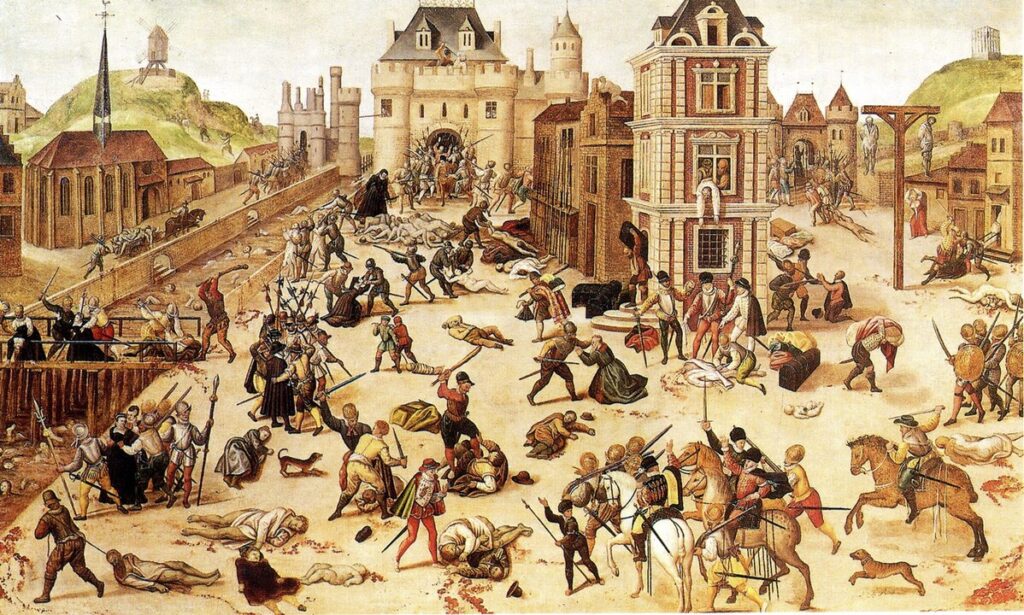
The St. Bartholomew’s Day Massacre by François Dubois (c. 1576). This event severely damaged Catherine’s reputation. By François Dubois
The background to this event included an assassination attempt on Protestant leader Admiral Coligny. Coligny had significant influence over Catherine’s son Charles IX, which Catherine reportedly feared. After the failed assassination attempt, Catherine and the royalists, fearing Protestant retaliation, allegedly decided to preemptively kill Protestant leaders.
Whether Catherine directly ordered this massacre remains a subject of debate among historians. However, this event undoubtedly damaged Catherine’s political reputation and reinforced her image as a “poisoner.”
Against this backdrop, how did Catherine become associated with the legend of poison?
Science and Magic in the Renaissance
The 16th century, when Catherine de’ Medici lived, was at the heart of the Renaissance. During this era, the boundary between science and magic was very blurred. Alchemy, astrology, and herbalism were actively studied, forming the foundations of modern science while retaining mystical elements.
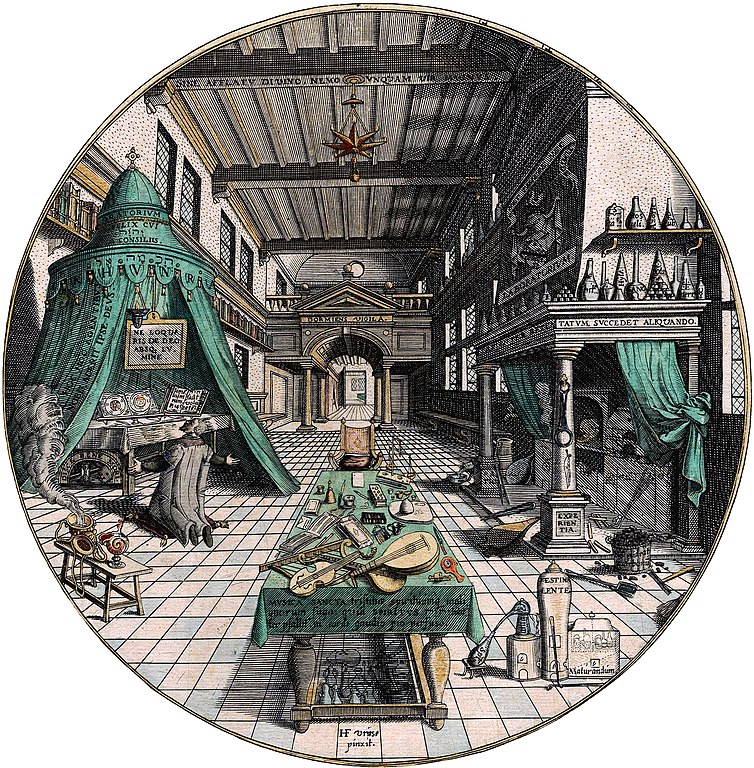
The Alchemist’s Laboratory (1595). An engraving from Heinrich Khunrath’s book ‘Amphitheatrum Sapientiae Aeternae’. This detailed depiction vividly illustrates the fusion of science and mysticism in late 16th-century alchemy, capturing the intellectual atmosphere of Catherine de’ Medici’s era. By Hans Vredeman de Vries
Herbalism, in particular, greatly contributed to the development of medicine. Various plants’ properties were studied, and new medicines were created by combining them. However, this knowledge was also applied to the study of “poisons.” Poison and medicine had a dual nature; substances that could function as medicine in appropriate doses could become deadly poisons if taken in excess.
In the French court of the Renaissance, such scientific experiments were widely conducted. Royalty and nobility set up laboratories in their castles, immersing themselves in the study of alchemy and herbalism. Catherine de’ Medici was likely influenced by these trends of her time.
How, then, did this scientific interest lead to Catherine’s association with the legend of poison?
Catherine and the Poison Legend
Catherine de’ Medici’s name became linked with “poison” due to a series of mysterious deaths surrounding her. One of the most famous cases was the death of Jeanne d’Albret, Queen of Navarre.
Jeanne d’Albret had come to Paris for the wedding symbolizing reconciliation between Catherine’s son Charles IX and the Protestant side. However, she suddenly fell ill and died a few days later. This sudden death sparked many rumors, with suspicions arising that Catherine had poisoned her.
The death of Diane de Poitiers, the mistress of Catherine’s husband Henry II, also raised suspicions. Diane was banished from court by Catherine after Henry II’s death and died shortly after. These incidents fueled rumors that Catherine used poison to eliminate her political rivals.
However, these rumors lack historical evidence. Given the medical knowledge of the time, it was difficult to distinguish between poisoning and natural death. The political conflicts and religious tensions within the court likely contributed to the spread of such rumors.
The legend of Catherine having a “poison laboratory” was passed down through generations. It was said that she had a secret laboratory in the Tuileries Palace she built in Paris, where she conducted poison research.

Part of the 1615 Paris map by Matthäus Merian. It shows the Louvre Palace (bottom center), the Tuileries Palace (bottom right), and the Grand Gallery connecting them. The Tuileries Palace, whose construction was initiated by Catherine de’ Medici, had already become an important royal residence by this time. By Matthäus Merian
Several factors contributed to the spread of this legend. First, Catherine’s Italian origin played a role. At the time, Italy was seen as the home of poisons and conspiracies in France, and Catherine’s background became associated with this image.
Additionally, the fact that Catherine was a woman with strong political influence fueled the legend. From the Middle Ages to the Renaissance, powerful women were often portrayed as “witches” or “poisoners,” and Catherine fell victim to such stereotypes.
Furthermore, Catherine’s scientific interests may have formed the basis for the poison legend. She actually set up an observatory in the court and invited the astrologer Nostradamus, showing a strong interest in the cutting-edge “science” of her time. This attitude may have been linked to rumors of her “poison laboratory.”
So, how did Catherine’s scientific interests actually manifest, and what contributions did they make?
Catherine’s Scientific Contributions and Their Evaluation
While it’s unclear whether Catherine de’ Medici actually conducted poison research, it’s undeniable that she made certain contributions to the scientific and technological development of her time.
Notably, Catherine introduced herbalism and perfume-making techniques from Italy to France. Influenced by the Italian Renaissance, she brought a new cultural wind to the French court.
The perfume-making techniques Catherine brought to France held significance beyond mere luxury items. Perfumes were used for medical and hygienic purposes at the time; for instance, strong-scented pomanders were used to prevent the plague. Catherine invited the Italian perfumer René le Florentin to France and spread perfume-making techniques.
The introduction of these perfume-making techniques greatly influenced French court culture. Perfumes became fashionable among the nobility, and eventually, France became the center of the perfume industry. It’s not an exaggeration to say that the foundations of the French perfume industry, represented by Grasse, were laid during Catherine’s time.
Catherine also contributed to the development of medicine. In 1566, she supported the establishment of the Royal College of Surgeons. This school played a significant role in elevating the status of surgeons and enhancing medical education. At the time, surgery held a lower status than medicine, but with Catherine’s support, the social status of surgeons improved, and the integration of medicine and surgery progressed.
Catherine also promoted anatomical research. Although human dissection was still somewhat taboo in her time, Catherine supported and encouraged the research of anatomist Ambroise Paré. Paré is known as the father of modern surgery, and his research greatly contributed to the development of French medicine.
Furthermore, the “poison-detecting dinnerware” that Catherine reportedly used is said to have been a scientific invention. These utensils were supposedly designed to change color if they came into contact with poisoned food, representing the pinnacle of chemical technology at the time.
However, Catherine’s scientific contributions were long overshadowed by the “poison” legend surrounding her. Her name became strongly associated with images of conspiracy and poisoning, distorting her true character.
So, how do modern historical studies evaluate Catherine de’ Medici?
Reevaluation of Catherine de’ Medici
In recent historical research, there has been a reevaluation of Catherine de’ Medici. The mainstream view now sees her not merely as a “poisoner,” but as a resilient female politician who sought to maintain power amidst complex political circumstances. At the same time, light is being shed on her scientific interests and cultural contributions.
For example, the arts and culture policies Catherine promoted are also subjects of reevaluation. She invited many artists and poets to the court, contributing to the flowering of French Renaissance culture. In particular, her role in the development of ballet was significant; the “Ballet Comique de la Reine” performed in 1581 is considered one of the origins of modern ballet.
Catherine’s political acumen is also being reviewed from a new perspective. In an era of religious conflict and civil unrest, finding a complete solution would have been difficult for anyone. In this context, Catherine strived to prevent the nation from falling apart, often through compromise. While her policies were not always successful, her efforts deserve recognition.
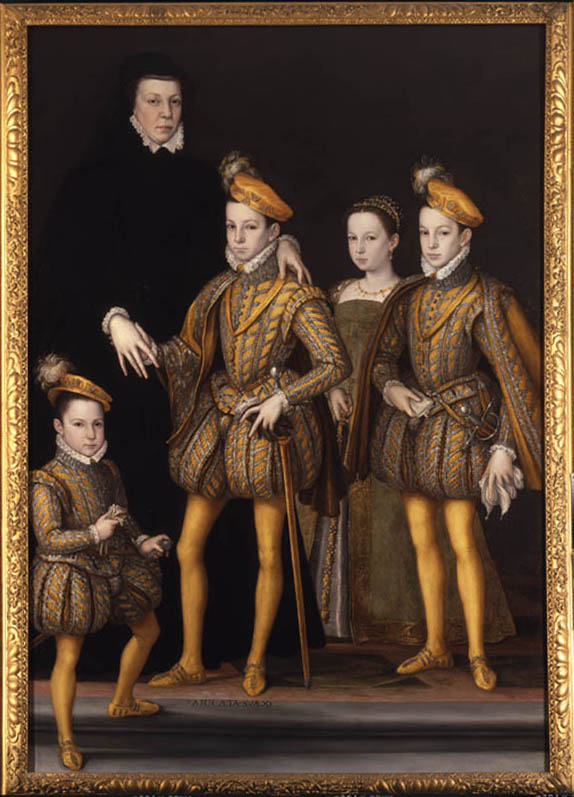
Catherine de’ Medici and Her Children by François Clouet (c. 1561). Catherine is depicted in widow’s attire at the top, with her children below from left to right: Charles (later Charles IX), Margaret of Valois, Henry (later Henry III), and Francis (Duke of Alençon). This portrait illustrates Catherine’s complex role as both a politician and a mother, transcending the stereotype of a ‘poisoner’. Her leadership during the religious wars and her position as a female leader raise issues that resonate with modern society. By François Clouet
As the reevaluation of Catherine de’ Medici progresses, what can we learn from her life?
What Catherine de’ Medici’s Life Teaches Us Today
The life of Catherine de’ Medici and the legends surrounding her offer many insights to us in the modern world.
First, it makes us consider the relationship between power and science. In the Renaissance period, scientific knowledge was the preserve of those in power. Catherine’s interest in scientific research may have been because she saw it as a means to maintain power. In modern society, too, the relationship between science, technology, and power is constantly questioned. We must always be vigilant to ensure that scientific progress is not used solely for the benefit of certain powerful individuals or groups.
Next, there’s the issue of how women are represented in history. Powerful women have often been stereotyped as “witches” or “poisoners.” Catherine’s case gives us an opportunity to reconsider such historical views. Even in modern society, prejudices against women in leadership positions still exist. The reevaluation of Catherine challenges these biases and suggests the need to review history from a more equitable perspective.
Furthermore, Catherine’s life makes us think about leadership in times of crisis. Faced with intensifying religious conflicts and the threat of national division, Catherine strived to maintain order, often through compromise. While her methods were not always successful, they demonstrate the complexity of decision-making in difficult situations. Modern leaders often face similar challenges. From Catherine’s experiences, we can learn much about crisis management and leadership.
Conclusion
The legend of Catherine de’ Medici’s “poison laboratory” can be seen as a product of the complex political situation in 16th century France and the scientific views of the Renaissance period. Whether she actually used poisons to eliminate her political rivals remains inconclusive even today.
However, there is much we can learn through this legend. The true character of Catherine de’ Medici cannot be fully captured by the “poison laboratory” legend alone. She was a figure who had a significant impact in the realms of politics, science, and culture during a turbulent era. By examining her life, including both her accomplishments and shortcomings, we can gain a deeper understanding of Renaissance France and the relationship between power and science.
The reevaluation of Catherine de’ Medici teaches us the importance of viewing history from multiple angles. The assessment of a single event or person can change over time. We need to maintain an attitude of constantly reviewing history from new perspectives.
Moreover, Catherine’s story provides an opportunity for us, living in the modern world, to reconsider issues of power, science, and gender. By learning from her experiences, we can approach the challenges facing contemporary society from new viewpoints.
History is not merely an accumulation of past events; it provides guidance for the present and future. The story of Catherine de’ Medici reminds us of this once again. Through her life, we are prompted to deeply consider the nature of power, the role of science, and the status of women in society. These issues continue to challenge us across the ages.
